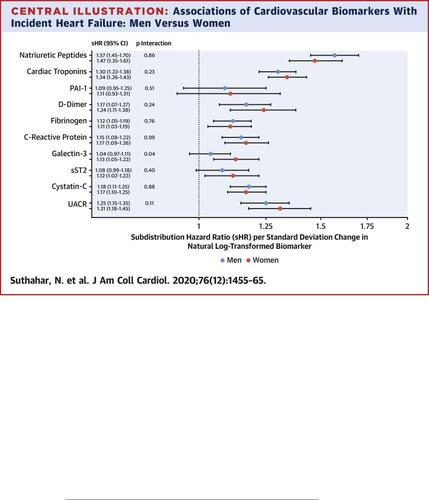当前位置:
X-MOL 学术
›
J. Am. Coll. Cardiol.
›
论文详情
Our official English website, www.x-mol.net, welcomes your feedback! (Note: you will need to create a separate account there.)
Sex-Specific Associations of Cardiovascular Risk Factors and Biomarkers With Incident Heart Failure
Journal of the American College of Cardiology ( IF 24.0 ) Pub Date : 2020-09-01 , DOI: 10.1016/j.jacc.2020.07.044 Navin Suthahar 1 , Emily S Lau 2 , Michael J Blaha 3 , Samantha M Paniagua 2 , Martin G Larson 4 , Bruce M Psaty 5 , Emelia J Benjamin 6 , Matthew A Allison 7 , Traci M Bartz 8 , James L Januzzi 2 , Daniel Levy 9 , Laura M G Meems 1 , Stephan J L Bakker 10 , Joao A C Lima 11 , Mary Cushman 12 , Douglas S Lee 13 , Thomas J Wang 14 , Christopher R deFilippi 15 , David M Herrington 16 , Matthew Nayor 2 , Ramachandran S Vasan 6 , Julius M Gardin 17 , Jorge R Kizer 18 , Alain G Bertoni 19 , Norrina B Allen 20 , Ron T Gansevoort 10 , Sanjiv J Shah 21 , John S Gottdiener 15 , Jennifer E Ho 2 , Rudolf A de Boer 1
Journal of the American College of Cardiology ( IF 24.0 ) Pub Date : 2020-09-01 , DOI: 10.1016/j.jacc.2020.07.044 Navin Suthahar 1 , Emily S Lau 2 , Michael J Blaha 3 , Samantha M Paniagua 2 , Martin G Larson 4 , Bruce M Psaty 5 , Emelia J Benjamin 6 , Matthew A Allison 7 , Traci M Bartz 8 , James L Januzzi 2 , Daniel Levy 9 , Laura M G Meems 1 , Stephan J L Bakker 10 , Joao A C Lima 11 , Mary Cushman 12 , Douglas S Lee 13 , Thomas J Wang 14 , Christopher R deFilippi 15 , David M Herrington 16 , Matthew Nayor 2 , Ramachandran S Vasan 6 , Julius M Gardin 17 , Jorge R Kizer 18 , Alain G Bertoni 19 , Norrina B Allen 20 , Ron T Gansevoort 10 , Sanjiv J Shah 21 , John S Gottdiener 15 , Jennifer E Ho 2 , Rudolf A de Boer 1
Affiliation

|
Background Whether cardiovascular (CV) disease risk factors and biomarkers associate differentially with heart failure (HF) risk in men and women is unclear. Objectives The purpose of this study was to evaluate sex-specific associations of CV risk factors and biomarkers with incident HF. Methods The analysis was performed using data from 4 community-based cohorts with 12.5 years of follow-up. Participants (recruited between 1989 and 2002) were free of HF at baseline. Biomarker measurements included natriuretic peptides, cardiac troponins, plasminogen activator inhibitor-1, D-dimer, fibrinogen, C-reactive protein, sST2, galectin-3, cystatin-C, and urinary albumin-to-creatinine ratio. Results Among 22,756 participants (mean age 60 ± 13 years, 53% women), HF occurred in 2,095 participants (47% women). Age, smoking, type 2 diabetes mellitus, hypertension, body mass index, atrial fibrillation, myocardial infarction, left ventricular hypertrophy, and left bundle branch block were strongly associated with HF in both sexes (p < 0.001), and the combined clinical model had good discrimination in men (C-statistic = 0.80) and in women (C-statistic = 0.83). The majority of biomarkers were strongly and similarly associated with HF in both sexes. The clinical model improved modestly after adding natriuretic peptides in men (ΔC-statistic = 0.006; likelihood ratio chi-square = 146; p < 0.001), and after adding cardiac troponins in women (ΔC-statistic = 0.003; likelihood ratio chi-square = 73; p < 0.001). Conclusions CV risk factors are strongly and similarly associated with incident HF in both sexes, highlighting the similar importance of risk factor control in reducing HF risk in the community. There are subtle sex-related differences in the predictive value of individual biomarkers, but the overall improvement in HF risk estimation when included in a clinical HF risk prediction model is limited in both sexes.
中文翻译:

心血管危险因素和生物标志物与心力衰竭事件的性别特异性关联
背景 心血管 (CV) 疾病危险因素和生物标志物是否与男性和女性心力衰竭 (HF) 风险存在差异相关尚不清楚。目的 本研究的目的是评估心血管危险因素和生物标志物与心力衰竭事件的性别特异性关联。方法 使用来自 4 个社区队列的数据进行分析,随访期为 12.5 年。参与者(1989 年至 2002 年期间招募)基线时没有心力衰竭。生物标志物测量包括利尿钠肽、心肌肌钙蛋白、纤溶酶原激活剂抑制剂-1、D-二聚体、纤维蛋白原、C-反应蛋白、sST2、半乳糖凝集素-3、半胱氨酸蛋白酶抑制剂-C和尿白蛋白与肌酐比。结果 在 22,756 名参与者(平均年龄 60 ± 13 岁,53% 女性)中,2,095 名参与者(47% 女性)发生心力衰竭。年龄、吸烟、2 型糖尿病、高血压、体重指数、心房颤动、心肌梗死、左心室肥厚和左束支传导阻滞与男女心力衰竭密切相关 (p < 0.001),并且综合临床模型显示对男性(C 统计量 = 0.80)和女性(C 统计量 = 0.83)具有良好的歧视性。大多数生物标志物与男性和女性的心衰都有密切且相似的相关性。在男性中添加利钠肽后(ΔC 统计量 = 0.006;似然比卡方 = 146;p < 0.001),以及在女性中添加心肌肌钙蛋白后(ΔC 统计量 = 0.003;似然比卡方 = 146;p < 0.001),临床模型略有改善(ΔC 统计量 = 0.003;似然比卡方) = 73;p < 0.001)。结论 心血管危险因素与两性心力衰竭事件密切相关,这凸显了风险因素控制在降低社区心力衰竭风险方面的相似重要性。个体生物标志物的预测价值存在细微的性别相关差异,但当纳入临床心力衰竭风险预测模型时,心力衰竭风险估计的总体改善在两种性别中都是有限的。
更新日期:2020-09-01
中文翻译:

心血管危险因素和生物标志物与心力衰竭事件的性别特异性关联
背景 心血管 (CV) 疾病危险因素和生物标志物是否与男性和女性心力衰竭 (HF) 风险存在差异相关尚不清楚。目的 本研究的目的是评估心血管危险因素和生物标志物与心力衰竭事件的性别特异性关联。方法 使用来自 4 个社区队列的数据进行分析,随访期为 12.5 年。参与者(1989 年至 2002 年期间招募)基线时没有心力衰竭。生物标志物测量包括利尿钠肽、心肌肌钙蛋白、纤溶酶原激活剂抑制剂-1、D-二聚体、纤维蛋白原、C-反应蛋白、sST2、半乳糖凝集素-3、半胱氨酸蛋白酶抑制剂-C和尿白蛋白与肌酐比。结果 在 22,756 名参与者(平均年龄 60 ± 13 岁,53% 女性)中,2,095 名参与者(47% 女性)发生心力衰竭。年龄、吸烟、2 型糖尿病、高血压、体重指数、心房颤动、心肌梗死、左心室肥厚和左束支传导阻滞与男女心力衰竭密切相关 (p < 0.001),并且综合临床模型显示对男性(C 统计量 = 0.80)和女性(C 统计量 = 0.83)具有良好的歧视性。大多数生物标志物与男性和女性的心衰都有密切且相似的相关性。在男性中添加利钠肽后(ΔC 统计量 = 0.006;似然比卡方 = 146;p < 0.001),以及在女性中添加心肌肌钙蛋白后(ΔC 统计量 = 0.003;似然比卡方 = 146;p < 0.001),临床模型略有改善(ΔC 统计量 = 0.003;似然比卡方) = 73;p < 0.001)。结论 心血管危险因素与两性心力衰竭事件密切相关,这凸显了风险因素控制在降低社区心力衰竭风险方面的相似重要性。个体生物标志物的预测价值存在细微的性别相关差异,但当纳入临床心力衰竭风险预测模型时,心力衰竭风险估计的总体改善在两种性别中都是有限的。

























 京公网安备 11010802027423号
京公网安备 11010802027423号